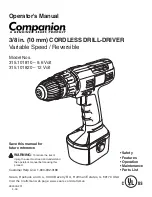
snom m9 DECT Administrator Guide
36
Each identity on the snom m9 can be configured to include these dial patterns.
Configuration
Dial plan entries consist of three parts (pattern, result, and flags), each of which may be separated by any char-
acter. Typically, the characters “!” or “|” are used as field separators.
•
Pattern:
The pattern field is used to interpret digit sequences that will be used to decide on routing.
In most cases, simplified expressions consisting of literals, prefixes, and fixed patterns will suffice.
—
Literals: If you want to match a specific number, just enter the exact number (e.g.,
911
). The
literal will be the first match in the expression.
—
Prefixes: Prefixes allow you to route numbers that begin with identical prefixes through the
same trunk. For example, by specifying the common prefix
9011
in the pattern field, all interna-
tional numbers will be routed through the same trunk. To indicate that a prefix is being using, an
asterisk must be entered after the prefix (e.g.,
9011*
).
—
Fixed patterns: If you use an
x
in a pattern, the system will treat it as a wildcard for 0-9. For
example,
978xxxxxxx
will route all calls beginning with the area code 978 through the same
trunk.
•
Replacement
: The replacement string is used to convert digit sequences into a dial string for out-
bound calling. It is used in the
To
header as well as in the Request-URI. Replacement strings are
found in the second part of the dial plan entry and are marked by a leading \
Replacement
Definition
d
The d replacement inserts the name of the registrar.
Example
:
!*!sip:\1@\d!
This replacement string inserts the domain name behind the @ symbol.q
www.InternetVoipPhone.co.uk | [email protected] | 0800 088 48 46
















































